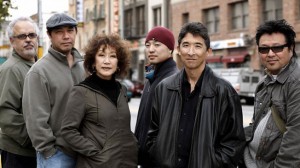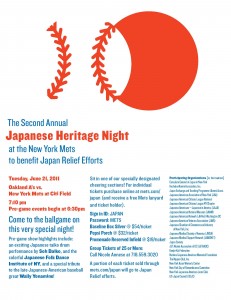Justin’s Japan: L’Arc~en~Ciel Marks 20 Years in Rock with Special Film Screening
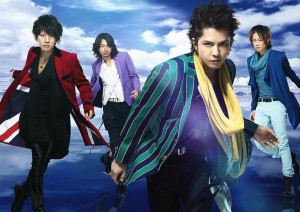
'The Best of L'Arc~en~Ciel 2 Days Live at Tokyo Ajinomoto Stadium' premieres Nov. 29 in New York. (Courtesy of Live Viewing Japan)
By JQ magazine editor Justin Tedaldi (CIR Kobe-shi, 2001-02) for Examiner.com. Visit his page here for related stories.
After 20 years, 13 million albums and 16 million singles sold, famed J-rock group L’Arc~en~Ciel is ready for its next career highlight: New York City.
On Nov. 29, movie theaters in Times Square and Union Square will unveil a special one-night-only music event for the band, which will be simulcast in eight other major American cities. The screening comes months ahead of their hotly anticipated live debut at the Theater at Madison Square Garden in March 2012.
Entitled The Best of L’Arc~en~Ciel 2 Days Live at Tokyo Ajinomoto Stadium, the concert film celebrates the group’s 20th Anniversary, traces their colorful history, and captures them in action at a gig last year that drew over 100,000 fans. The screening is presented by Live Viewing Japan in partnership with Maverick DC Group.
Live Viewing Japan is a distribution company focused on bringing Japanese entertainment media to an international audience. In New York earlier this month, they screened a concert showcase by superstar virtual idol Hatsune Miku (read this Examiner’s review here), and L’Arc~en~Ciel’s film has already made the rounds in São Paulo, Jakarta, Singapore, and will beam its way to London next month.
For the complete story, click here.
Justin’s Japan: Theatre Review — ‘Kutsukake Tokijiro’ an Inspired Yakuza Yarn
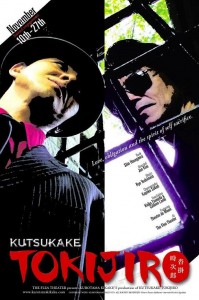
'Kutsukake Tokijiro' runs through Nov. 27 at New York's Flea Theatre. (Courtesy of Kurotama Kikaku Company)
By JQ magazine editor Justin Tedaldi (CIR Kobe-shi, 2001-02) for Examiner.com. Visit his page here for related stories.
Mounting a 1920s Japanese gangster play with J-pop flavored fillips may seem like a tough sell, but the new Off-Off-Broadway production of Kutsukake Tokijiro is a successful hybrid that should appeal to fans of “world” stage productions.
Opening last week at Tribeca’s Flea Theater and running through Nov. 27, Kutsukake Tokijiro (if you can pronounce it, you’ve probably already seen it) caps a nearly three-year journey to the stage by New York’s Kurotama Kikaku Company and its artistic director, Jun Kim. A native of Japan with Korean heritage, Kim is an actor, dancer, and director of the show, doing double duty in the opening scenes as Mutsuda-no-Sanzo, the target of the titular Tokijiro (played with noble gravitas by Yasu Suzuki).
If these names sound hoary, consider the source material: written by Shin Hasegawa in 1928, KT is a hallmark of Japanese popular theatre, based in turn upon on a 19th century Japanese Yakuza/lone gambler story cut almost from the same cloth as the Spaghetti Western. In its first-ever English translation by the venerable Keiko Tsuneda, KT is reborn for an American audience.
Kim’s vision for a 21st century KT is to inject Japanese pop culture animation and folk songs as well as the dance movements of Noh, Kabuki and contemporary dance to form a “J-pop Theatre.” This is achieved via Japanese-language scenes between Tokijiro and his rivals (English supertitles are helpfully flashed above center stage) and through his more tender moments with Sanzo’s widow, Okinu (Hiroko Yonekura), whom Tokijiro elopes with along with her young son Tarokichi (Asuka Morinaga).
For the rest of the article, click here.
Justin’s Japan: Film Review – ‘Hatsune Miku Live Party 2011 39’s Live in Sapporo’
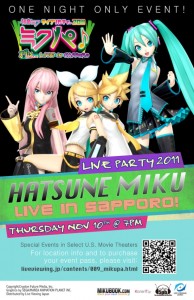
"With New York going bananas in between numbers and the room itself mimicking the Sapporo show with timed strobe and lighting effects—the theater’s management really went the extra mile—it truly felt like being at a concert." (Courtesy of Live Viewing Japan)
By JQ magazine editor Justin Tedaldi (CIR Kobe-shi, 2001-02) for Examiner.com. Visit his page here for related stories.
On Nov. 10 a one-time theatrical screening was held for a new concert film from virtual pop phenom Hatsune Miku. Entitled Hatsune Miku Live Party 2011 39’s Live in Sapporo, the film—captured in August at the 2,000 capacity Zepp Sapporo—is Miku’s latest appearance in America following a Toyota ad campaign and live gigs at L.A.’s Nokia Theatre and the San Diego Comic-Con earlier this year. (In fact, this reporter was interviewed for Japanese TV about that; click here for the news clip.)
Hatsune Miku, whose name means “first sound of the future,” is a Vocaloid (meaning machine-made vocals) digital female avatar and the most popular of Crypton Future Media characters that employ Yamaha technology to create synthesized vocal tracks, similar to Auto-Tune. In Japan, Miku is massively successful and has appeared in numerous popular video games and music videos, and her Sailor Moon-meets-Avril Lavigne image (she is a teen idol, after all) is equally fanboy and fangirl friendly.
Presented by Live Viewing Japan and simulcast in nine U.S. cities, this screening was shown to a capacity Times Square crowd. From the moment Miku’s name flashed up on the dark screen five seconds in, the audience was hooked. Wild applause, shrieks and excitement from the mostly American teens and twentysomethings in the crowd took the older folks by surprise. “This is like Paul McCartney to us,” remarked one lady several seats away. (She and her companion left about an hour in.)
For those unfamiliar with J-pop, the genre’s credo is style over substance (Katy Perry and Lady Gaga are our closest counterparts), but just like with our pop tarts, a catchy hook is a catchy hook. With a black, completely bare stage flanked by a five-piece band (yes, the music seems to be performed live), the only thing besides Miku noticeable throughout are the hundreds of lime green glow sticks pumped energetically by the fans throughout. Again, this was mirrored by the Times Square audience as one enterprising otaku passed out five blue ones (not to be outdone, he carried a massive Darth Maul-ish staff that lit up a chunk of the theater.)
For the rest of the article, click here.
A (Culturally) Stimulating Interview with the Insatiable Asa Akira

“I think I have a lot of Japanese culture ingrained in me. Just from being from a Japanese family, living in Japan. The whole ‘respect your elders,’ that, to me, is the main thing that’s different between America and Japan.”
Porn porn
By Michael Karns (CIR Kobe-shi, 2001-02) for JQ magazine. Michael is an avid photographer.
The winner of five AVN Awards (like the Oscars, but without Cuba Gooding, Jr.), Asa Akira returned to the East Coast last weekend for a rare promotional trip. In the spirit of intensifying relations between our nation and Japan, we spoke with the scintillating 25-year-old superstar/native New Yorker about her Japanese roots, her favorite anime films, and the deeper cultural points that America and Japan can swap with each other.
Regarding your Japanese heritage, where is your family originally from?
My mother’s side of the family is from Osaka and my father’s side is from Tokyo, but they live in Yokohama.
You went to an American school growing up.
I did, a very prestigious American private school. It was nice.
When Japanese students relocate to America, it can be difficult adjusting. How was it for you relearning the way of life here?
I was born in New York City and I moved to Japan when I was six, so I already had a little America experience, but it was definitely a huge culture shock. Kids in Japan are really good, even American ones. So coming to New York was like, “Oh my God, these kids are 12 years old and they’re doing drugs!” It was definitely a huge culture shock, and I totally bought into it for a little bit (laughs).
You’ve got an incredible personality…
Thank you.
What do you attribute this to?
I grew up around boys; I think that has a lot to do with my sense of humor. Me and this other girl were always the only two girls in this group of boys, so I think we grew up with a really good sense of humor, you know?
So are you kind of like an otemba (tomboy)?
Yeah (laughs).
That’s my type, by the way.
Oh, good (laughs).
Regarding Japanese culture, what things do you like the most about it? Are there any films or other things that you point to as an inspiration?
I think I have a lot of Japanese culture ingrained in me. Just from being from a Japanese family, living in Japan. The whole “respect your elders,” that, to me, is the main thing that’s different between America and Japan. People in America treat old people like [expletive].
I love my grandmother, but I know what you’re talking about.
(Laughs) And they just don’t listen to older people. I think that’s weird. So that would be the main thing.
Justin’s Japan: Interview with the English Dub Cast of ‘Dragon Ball Z’ at New York Comic Con
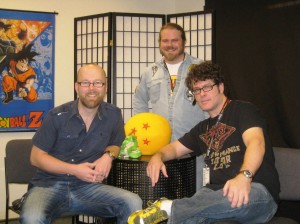
One down, six to go: Voice actors Christopher Sabat, Justin Cook, and Sean Schemmel of 'Dragon Ball Z.' (Justin Tedaldi)
By JQ magazine editor Justin Tedaldi (CIR Kobe-shi, 2001-02) for Examiner.com. Visit his page here for related stories.
To celebrate the 15th anniversary of its English-language debut, Dragon Ball Z is coming to Blu-ray for the first time in America. The November release of Dragon Ball Z Level 1.1 contains the first 17 episodes of the anime series that dominated Japan’s pop culture scene in the 1990s and later, the rest of the world. This newly remastered collection restores the original, director-approved color scheme and 4:3 aspect ratio in stunning 1080p HD, and each volume will include rare never-before-seen special features.
In this exclusive interview conducted at New York Comic Con/Anime Festival (where I also talked with Stan Lee), I spoke with three of the English dub cast members: Christopher Sabat (Vegeta/Piccolo/Yamcha/voice director), Justin Cook (Raditz/Super Buu/ADR engineer), and Sean Schemmel (Goku/King Kai/Nail) about the release, their favorite Dragon Ball memories, and the proper context for discussing one’s favorite cartoon crush.
Regarding your approach to the characters’ voices, how much of the original Japanese voice work did you watch? For the voices you replaced, how much of that did you take into consideration?
Chris: At the start, a lot of consideration was taken to the original voices, and when I say original voices, I mean the Canadian cast [whose English dub work aired from 1996-98], because at the time [Dragon Ball’s North American producers] FUNimation had decided for a multitude of reasons that it was just physically impossible for them to record in Canada any longer. It was difficult to keep the actors consistent on the roles, because a lot of the Canadian actors were cast in other things, and sometimes it would make their job difficult. In fact, they had to recast Goku several times in Canada; they didn’t want to do that anymore. And it also made more sense to be closer to the parent company, so they moved it all down to Fort Worth.
We tried to take a lot of care at the beginning to match the Canadian cast, only because we didn’t want it to be too much of a shock, and when I say “we” I guess I mean the people who hired me—they didn’t want it to be too much of a shock to the American culture when they changed out these voices. And to be honest, when we first started recording this, we didn’t really have access to the Japanese versions of the show; we were dubbing off the Spanish version of Dragon Ball Z. So if we ever listened to the original language on the tape, it was like (speaks in a rapid mock Spanish): “Goku! Dragon Ball Zeta!” [Goku’s wife] Chi-Chi’s name was Milk.
We were just trying to keep it consistent to the first 68 episodes, and it wasn’t until later that we were redubbing the show that we actually started getting in the real Japanese versions of the show and had the technology to be able to quickly preview the Japanese files. We didn’t even have digital files yet, and sometimes we didn’t even get all the original materials that had the Japanese track on it; sometimes we were lucky if it had any sound on the tape at all…the [original] Japanese wasn’t an option.
Have you been to Japan before? If not, what would you want to do there?
Sean: I have plenty ideas about what I want to do in Japan. I have not been to Japan; I really want to go. My goal is to become a background character in an anime, so I can say this (with mock surprise): “Nani?!” (what) and that’s it. I want it to be one line, to be a Japanese seiyū [voice actor]. Give me something longer than that (in a gruff voice): “Ware ware…” (we) something, but just one line; that’s my goal. And, to meet Masako Nozawa [the original voice of Goku] and maybe, if I were lucky, [Dragon Ball creator] Akira Toriyama, but that’s probably never going to happen.
If you met Toriyama-sensei, what would you ask him?
Sean: I would just thank him, because when you think about it, here’s this guy that draws this comic book, there’s this massive explosion—that I’m on the periphery of, if you think about it—[that] radically changed my life forever. So I’d be extraordinarily grateful to that guy.
Read the complete story here.
Justin’s Japan: Interview with cartoonist Adam Pasion on ‘Aftershock’ and ‘Sundogs’

"'Aftershock' is supposed to communicate how far-reaching the influence of Japan has been on cartoonists all over the world, and how we feel in a moment like this. I guess more than an open letter, it's a get well card." (Courtesy of Adam Pasion)
By JQ magazine editor Justin Tedaldi (CIR Kobe-shi, 2001-02) for Examiner.com. Visit his page here for related stories.
For the past several years Adam Pasion has been living in Nagoya, which he calls “Japan’s best kept secret.” An editor and illustrator for RAN magazine, he is also a co-owner and English teacher of SpeakEasy Language School. As the creator of his own comic diary series Sundogs, the San Jose native was profiled in The Japan Times earlier this year, and the strip has since been collected into three books, providing a daily document of Pasion’s life in Nippon with his growing family from 2008 through 2010.
His latest project is Aftershock: Artists Respond to Disaster in Japan, a global response to the combined disasters of this year’s Tohoku earthquake, tsunami and nuclear meltdown. Edited and complied by Pasion and representing over 35 contributors from five continents, including Jeffrey Brown, Ben Snakepit, and JET alum Lars Martinson (Fukuoka-ken, 2003-06), the book shares their thoughts and feelings about a freshly devastated Japan in manga form. In this exclusive interview, Pasion reveals the inspiration for this unique project, his favorite Sundogs moments, and what’s next on his plate.
Tell us about your history with Japan. How did it cross your radar growing up?
My hometown had a pretty big and vibrant Japantown, and we would often go there and eat or go window shopping as a kid, but beyond that Japan was just a point on a map for me. In college I worked with a Japanese girl who tried to get me to go to some club for Japanese exchange students. I reluctantly went and was surprised by how much I enjoyed it—tons of delicious Japanese food and lots of cute girls. I started going regularly, and that is where I met my wife. I started taking a Japanese class, and through that class I got offered a position working in Japan for a summer. After spending a summer working here, I fell in love with the place. Several years later, my wife and I found out that we were going to be having a baby, and we decided to come have the baby close to my wife’s family here in Nagoya. Four years, two kids and a couple belt sizes later, and we are still here.
How did Aftershock come together following the earthquake and tsunami of March 2011?
Like most people out there who have any sort of connection to Japan, I felt paralyzed by the whole thing. Here were all these terrible events unfolding just a few hundred miles up the coast and there was nothing I could do about it. I had a sort of “survivor’s guilt” by proxy. When the medical teams and disaster relief groups started to come in I felt even more uneasy, realizing that it was in fact possible to help, just impossible for me to help. Every place I looked told me “just donate money for now.” I felt like I was sitting in the waiting room, waiting for the doctors to do their job. All I could do was wait, and offer to help with the hospital bills.
Then one night my brain was racing as I was trying to go to sleep, and the idea occurred to me to find a way to help out within my own skill set, which is where the idea for this book came about. I jumped out of bed and immediately fired off about 10 e-mails to the cartoonists I knew personally, and the response was 100 percent positive. I contacted Top Shelf Productions after that on a whim and they were into the idea right away. I still felt like any moment it would vanish in smoke until out of the blue I started getting tons of requests to join the project and submissions from people I had never met. The word had gotten out and was spreading quickly, and at that point I knew we were on to something. When things with Top Shelf didn’t pan out, the project already had way too much momentum to give up, which is why I decided to self-publish it. When the book was funding on Kickstarter, I actually had people thanking me for the chance to pledge money to the project. I still can’t wrap my head around that.
What are your goals with releasing Aftershock?
This has been a major point of misunderstanding from a lot of people. The main goal of this project is not fundraising for a charity. That is certainly a big part of it, but the distinction is that even if it fails to make a lot of money, I think it is incredibly meaningful in its own right. From the beginning I have described this book as a kind of “open letter” to the nation of Japan from the international comics community. It is supposed to communicate how far-reaching the influence of Japan has been on cartoonists all over the world, and how we feel in a moment like this. I guess more than an open letter, it’s a get well card. It is also a timepiece that encapsulates the popular sentiment of the world at one moment. I want all the contributors to look back on this book and remember exactly where we were and how we felt while we were still in the thick of it. I think we have succeeded in this goal. We have created a lasting piece of art that captures an important moment in time and the zeitgeist that goes along with it.
Some people have misunderstood the purpose of the project as a way to donate to the disaster. It certainly is [all proceeds from Aftershock will be donated to relief efforts in northeast Japan—Ed.], but if your main purpose is to make a donation, then there are much more direct ways to do it than to buy this book. I want the book to be successful in its aim to raise as much money as possible to help in the rebuilding process, but I also want people to actively become involved. Read the stories and see why we care so much. I want it to motivate people to join the process of rebuilding and I want it to help people feel like we are all in this thing together.
For the complete story, click here.
Justin’s Japan: Hiroshima lends its divine sound to NYC Japan benefit concert
By JQ magazine editor Justin Tedaldi (CIR Kobe-shi, 2001-02) for Examiner.com. Visit his page here for related stories.
A staple of the Los Angeles jazz scene since 1974, Hiroshima returns for an East Coast engagement tonight (Sept. 21) to headline a Japan relief benefit concert with special guest stars at New York’s B.B. King Blues Club & Grill.
The only Asian American band to have been nominated for a Grammy, the group’s most recent album, 2009’s Legacy, celebrates Hiroshima’s 30th anniversary of recording and serves as a re-visitation of songs (like the easy listening favorite “Roomful of Mirrors” and ’80s hit single “One Wish”) from the band’s first decade.
Led by original members Dan and June Kuramoto, the group proved itself a musical chimera from the start with its self-titled debut, mixing elements of jazz, pop, and R&B with traditional Japanese instruments. Dan has remarked that at the time in America, music was the only outlet of cultural diversity available, and the resulting disc was a pioneering voice in the world music movement that followed.
For the complete story, click here.
Justin’s Japan: Japan Society Remixes a Greek Masterpiece with ‘Medea’
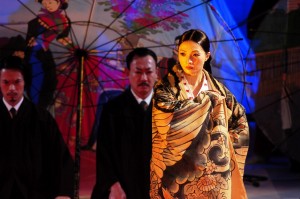
Micari stars in Satoshi Miyagi's production of 'Medea,' running Sept. 23-25 at New York's Japan Society.
By JQ magazine editor Justin Tedaldi (CIR Kobe-shi, 2001-02) for Examiner.com. Visit his page here for related stories.
Looking for an Eastern take on a Western classic? Japan Society kicks off its fall 2011/spring 2012 performing arts season with the Shizuoka Performing Arts Center (SPAC)’s production of Medea with a three-performance engagement from Sept. 23-25.
Directed by SPAC artistic director Satoshi Miyagi, the performance makes its North American premiere as a visual feast on the scale of a kabuki play. Set in 19th century Japan among the nation’s imperialist, gender-divided late Meiji era, this bold reinterpretation of Euripides’ evergreen features a company of 19 presented in Miyagi’s distinct bunraku puppet theater-inspired style accompanied on stage by live music.
Performed in Japanese with English subtitles, this stunning and internationally acclaimed production has traveled to 20 cities and 11 countries since its premiere in 1999. It also marks the return of SPAC to Japan Society, where the troupe mounted productions of Electra and Oedipus Rex during national tours for both.
For the complete story, click here.
Justin’s Japan: Interview with Billy Sheehan of Mr. Big on Touring Tohoku
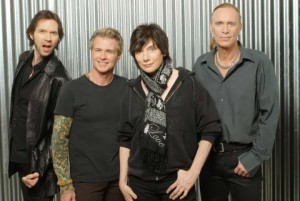
Billy Sheehan, right, with Mr. Big: "We had raised about $100,000 for the earthquake relief, and there’s still more to be raised, too. In the end, we raised a bunch of money, and we got a special letter from the Japanese Embassy in Washington, D.C. thanking us for being there." (William Hames)
By JQ magazine editor Justin Tedaldi (CIR Kobe-shi, 2001-02) for Examiner.com. Visit his page here for related stories.
One of the most respected bassists and gentlemen in the music world, Billy Sheehan is back with Mr. Big, the Los Angeles-based rock band he formed in 1988 best known for the hit ballad “To Be with You,” which shot to number one in 15 countries, including the U.S., in 1992. After splitting a decade later, in 2009 the original lineup reformed, followed by the release of What If…, the first album in 15 years from the original lineup.
Now, American fans are finally going to get a chance to see Billy, Paul Gilbert, Eric Martin and Pat Torpey together on stage since their ’90s heyday for a month-long American tour beginning Saturday (July 30) at San Diego’s 4th & B. In this exclusive interview, I spoke with Billy on Mr. Big’s current jaunt around the world, their triumphant return to Japan (where the band is revered), and the possibility of another album from the guys.
So far this year Mr. Big has played all over Europe, Asia and South America. What have your highlights been?
Japan is always amazing. The most difficult thing about touring is getting to and from the gigs…once we’re onstage, there’s no trouble at all, and in Japan, it’s just a breeze. We don’t fly in much, and take a lot of bullet trains, which are super convenient and easy and clean and safe and fast and everything. So Japan is always easy. The rest of Southeast Asia was actually pretty cool, too. We were supposed to do two shows in China, but the Shanghai show got cancelled because the promoters had the wrong visa for us. The shows in Korea, Taiwan and the Philippines were unbelievable, and in Taiwan we actually had to speed away from the venue in a van with literally crowds of people chasing after us (laughs). It was hilarious.
Mr. Big toured Japan less than one month after the earthquake and tsunami, and even did gigs in Iwate and Miyagi Prefectures, the areas most affected by the devastation. What was that experience like?
Really touching. There was a [camera] crew meeting us at the airport and then following us around, and we didn’t know, but they went out in the crowd and interviewed a lot of people, so later on we saw that they had interviewed a guy…I think he was from Sendai. They interviewed him for television, and we didn’t see it until we saw the show. He’d lost everything, and a couple of friends and family, and he’d lost his entire Mr. Big collection, so he actually came to the show to start his collection over again. And I’m telling you, it was so touching, this poor guy, that in his life, the important thing was to come and get his music back together again, really amazing. We had raised about $100,000 for the earthquake relief, and there’s still more to be raised, too—I just saw another $22,000, and I have to see what the figures are for the downloads of the special song we did [“The World Is on the Way”], also, so there’s a bunch more, too.
In the end, we raised a bunch of money, and we got a special letter from the Japanese Embassy in Washington, D.C. [signed by Ambassador Ichiro Fujisaki] thanking us for being there. We didn’t know how it would go when we went there, was it too soon or not, but [remember] after 9/11, where after the dust cleared, all the playhouses and restaurants were going out of business because nobody was going to New York City, so what helped was that going to see a show and having dinner to help the economy rolling again, so we were hoping to get that idea happening. We heard from saké dealers that were going out of business because nobody was drinking because they were all in mourning, you know? It’s a shame that so many lives were lost, but one of the most important things after anything like that is to get back up on your feet again. So I think we helped a bit—I’m cautiously optimistic to say I think we helped a bit. And from the tone of the e-mails and speaking with people after the show, we’re very pleased. So it all ended good.
Was there any hesitation at all about playing those gigs because of the radiation?
For me, no. A couple of the guys in the band were a little concerned about it. I fly transoceanic all the time [across] the Pacific, and you get a dose of radiation every time you do that. I think it’s equivalent to—I forget the figure—one, two or three chest X-rays just by flying over the ocean. And I do know that radiation, to incite fear in people, is almost second to none, you know? It’s invisible, and you don’t know it’s there and the next thing you know, you’ve got a problem. So I knew that there was probably some elevated degree of danger, but I also know that most things of that nature are over-exaggerated, in my experience with my own personal catastrophes of earthquakes and whatever else. They really do overblow it.
So I wasn’t worried personally, but we were more concerned for the fans, and I know that the Japanese government is very conscientious with their safety and rules. I remember I was in Tokyo one time, and there was a typhoon warning for everyone to stay inside. This was years ago, and I was out with a friend of mine, we were walking around, and the streets were deserted; there was nobody anywhere…the people in Japan are really in tune with the warnings and such. And I found out the government wouldn’t have allowed [us] to go on if we were to put a crowd of people in danger, so there was that factor, as well. So a couple of the guys in the band were a little worried about it, but I was okay with it, and in the end, all of us are glad we did it.
For the complete interview, click here.
For Justin’s February 2011 interview with Billy, click here.
Justin’s Japan: Lincoln Center Festival Premieres ‘Temple of the Golden Pavilion’
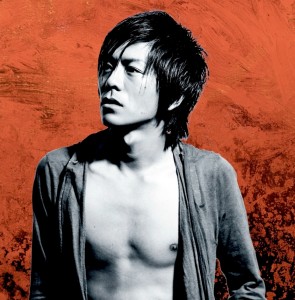
J-pop singer Go Morita stars in director Amon Miyamoto's stage adaptation of 'The Temple of the Golden Pavilion' for the Lincoln Center Festival July 21-24. (Miow Hirota)
By JQ magazine editor Justin Tedaldi (CIR Kobe-shi, 2001-02) for Examiner.com. Visit his page here for related stories.
On Thursday (July 21), this year’s edition of the Lincoln Center Festival will present the U.S. theatrical premiere of director Amon Miyamoto’s The Temple of the Golden Pavilion, based on Kinkakuji, the celebrated 1956 novel by Japan’s storied 20th century writer Yukio Mishima.
With a script co-written by Miyamoto and playwright Chihiro Ito, the play will run through July 24 at Columbus Center’s elegant Rose Theater.The Temple of the Golden Pavilion is a stunning tale of the power of beauty and its corruption of the mind of a young monk, Mizoguchi, who becomes obsessed with beauty’s destruction. This groundbreaking work paints an intensely personal picture of Japan in the crucible of the Second World War.
A native of Tokyo and the artistic director of the new Kanagawa Arts Theatre in Yokohama, Miyamoto hosted a special lecture last month at New York’s Japan Society. He made his Lincoln Center Festivaldebut in 2002 with a memorable production of Stephen Sondheim and John Weidman’s Pacific Overtures at Avery Fisher Hall, which moved on to the Kennedy Center for the Performing Arts and a Broadway revival from 2004 to 2005.
For the complete story, click here.
Justin’s Japan: Superstar Sora Aoi Appears This Week at Japan Society’s JAPAN CUTS 2011

'Three☆Points' star Sora Aoi will appear at New York's Japan Society July 15 with the film's director Masashi Yamamoto. (Courtesy of Japan Society)
After doing boffo box office last week with sold-out screenings of Osamu Tezuka’s Buddha, Battle Royale and the Gantz duology, Japan Society’s JAPAN CUTS 2011 will reach the boiling point this Friday (July 15) with a very special guest: international cause célèbre Sora Aoi. With a career spanning nearly a decade in Japan’s adult video (AV) industry, Aoi (whose stage name translates to “blue sky”) has also moonlighted in television dramas, film and mainstream entertainment, even enjoying success in China as a pop singer.
The actress will appear at Japan Society supporting her latest drama, Three☆Points, with its director Masashi Yamamoto helming a Q&A. The pair will also join a special after party after the screening to meet fans personally. Other Special guests slated for the rest of JAPAN CUTS include The Seaside Motel director Kentaro Moriya, A Liar and a Broken Girl director Natsuki Seta (both July 16), and Haru’s Journey director Masahiro Kobayashi (July 20).
All films—most of them New York premieres–are primarily shown in Japanese with English subtitles, some with actor/director intros and Q&As and after parties.
For more on the remaining cuts, click here.
Justin’s Japan: Japan Society’s First Week of JAPAN CUTS 2011 Offers ‘Buddha,’ ‘Battle Royale’

Japan Society of New York's JAPAN CUTS 2011 film festival kicks off with 'Osamu Tezuka’s Buddha: The Great Departure' July 7. (© 2011 Osamu Tezuka’s Buddha Production Committee)
By JQ magazine editor Justin Tedaldi (CIR Kobe-shi, 2001-02) for Examiner.com. Visit his page here for related stories.
Seeking summer movie asylum from Autobots and aging boy wizards? Head to Japan Society.
Now in its fifth consecutive year, the JAPAN CUTS 2011 film festival includes 32 new titles—the biggest lineup in the festival’s history with (almost) nothing but premieres and one-off shows—running from July 7 to 22, including ten co-presentations with the New York Asian Film Festival (NYAFF).
“Arguably North America’s premier showcase for Japanese film” (Firefox News), JAPAN CUTS screens the cutting edge of contemporary Japanese fare, caroming between elegant drama to anything-goes comedy to uncanny experimentalism.
All films—most of them New York premieres–are primarily shown in Japanese with English subtitles, some with actor/director intros and Q&As and after parties.
For the complete list of this week’s cuts, click here.
Justin’s Japan: Interview with “Tokyo Vice” Author Jake Adelstein on Yakuza Films, Umbrellas
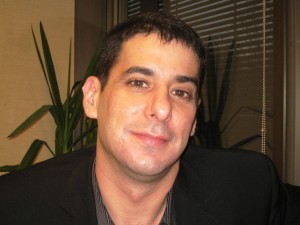
"I think the JET Program is a wonderful thing. Many people who have become scholars of Japan and have settled down in Japan begin on the JET Program. It is a wonderful way for the Japanese to get to understand Americans, and Americans to get to understand Japan." (Justin Tedaldi)
By JQ magazine editor Justin Tedaldi (CIR Kobe-shi, 2001-02) for Examiner.com. Visit his page here for related stories.
Examiner’s note: The following interview was conducted at New York’s Japan Society on March 10, 2011, hours before the Tohoku earthquake and tsunami would ravage eastern Japan. I was there to chat with guest lecturer Jake Adelstein, whose twelve-year career as a crime reporter for the Yomiuri Shinbun was chronicled in his acclaimed 2009 book Tokyo Vice. Adelstein is currently working on his second book, and as the editor of the Japan Subculture Research Center blog he continues to report on all the intriguing and seedy aspects that keep Japan running. In this exclusive interview, I spoke with Adelstein during an ominous cloudburst.
Thanks for meeting in this gloomy weather.
I used to like rainy weather, but my bodyguard, who’s an ex-yakuza, hates rainy weather. And I asked him once—I wish I hadn’t asked him—“What’s your deal with rainy weather? Why do you always not want to go out of the house and discourage me from going out?” And he’s like, “Oh, you know, when a yakuza kills another yakuza, they almost always do it on a rainy day, because first of all: bad visibility. The sound of the rain blurs the sounds of what’s going on, and the rain washes away all the trace evidence.” And ever since then, I haven’t been able to enjoy rainy weather as much as I used to.
I read that your birthday is coming up.
Well, let’s see. I’ll be 42. If all goes well, I will be ordained as a Soto Zen Buddhist priest on my birthday. I’ve got about a week of training left—if I could just remember that damn sutra. I had a talk with the priest and told him that I didn’t believe in the metaphysics of Buddhism, and he was like, “It’s all right. You just have to pretend that they’re true.” So as long as you uphold the precepts, it’s not belief; it’s deeds. I’m comfortable with that, the Episcopal King James version of Buddhism.
In an interview last year, you said you were going to have the opportunity to meet with yakuza boss Goto Tadamasa…
I might still have the opportunity, if he’s in good health. He’s been in and out of the hospital.
That’s his current status?
Yeah. He is still a priest. I’ve had some issues with his autobiography that was published last year, which had the equivalent of a yakuza fatwa on me. If you understand how the yakuza order people to be killed, you can read the lines very well. He refers to the attack on the director Itami Juzo in his memoirs and says, “Of course he deserved to be attacked, because he wrote a movie that was unpleasant about the yakuza,” and he refers to my writing as unpleasant. And then he has these two lines about, “I don’t know who this guy is, but even as an ex-yakuza, if I ever met him he would go from someone being targeted for death to someone being dead, ha-ha-ha.”
When a boss wants someone whacked in the yakuza, what he does is, he never gives an order, because then he could be held responsible. He just says, you know, “Johnson-san is a real pain in the ass; I don’t really like Johnson-san very well.” And his cohort immediately knows that he’s been asked to whack the guy. He whacks him and goes to jail, and comes out and gets a cash bonus from the organization. That’s how it’s done.
There’s talk that a film version of Tokyo Vice is in the works.
John Lesher, who produced No Country for Old Men, is signed on as the producer. There have been two or three actors who have expressed interest in playing the role. J.T. Rogers, who is a very good playwright—he’s got a play opening at Lincoln Center this year called Blood and Gifts—he is the principal screenwriter, and I am the co-writer. J.T. and I went to the same high school together. Actually, it’s interesting: he’s a very successful playwright, writes about Afghanistan and foreign countries. Peter Hessler, who is a China expert, he and I also hung out in high school at the same time.
What are your thoughts on the JET Program?
I think the JET Program is a wonderful thing. Many people who have become scholars of Japan and have settled down in Japan begin on the JET Program. It is a wonderful way for the Japanese to get to understand Americans, and Americans to get to understand Japan. Like any program, it has problems. I think it’s a great thing, and I hope it continues to be supported by both sides.
Justin’s Japan: New York Mets’ Japanese Heritage Night Aids Disaster Relief Efforts
By JQ magazine editor Justin Tedaldi (CIR Kobe-shi, 2001-02) for Examiner.com. Visit his page here for related stories.
Following the success of last year’s inaugural Japanese Heritage Night at Citi Field, this new tradition’s second edition on June 21 will pit the New York Mets against ex-Yankee Hideki Matsui’s Oakland A’s.
Scheduled for the pre-game show to celebrate Japan’s culture and heritage are New York-based taiko troupe Soh Daiko; the Japanese Folk Dance Institute of New York; a tribute to Wally Yonamine, the first American to play professional baseball in Japan after World War II; and the Spirit Award to the People of Tohoku to be accepted by Ambassador Shigeyuki Hiroki of the Consul General of Japan in New York. A portion of each ticket sold will benefit Japan earthquake and tsunami relief efforts.
Sponsored by the Japanese community of New York, the event is also supported by those outside the five boroughs. California-based artist Andrea Fono purchased two tickets for the game to support the cause in recognition of the enormous contributions Japan has made to other countries, including her husband’s homeland of Fiji, which Japan donated tents and blankets to after Cyclone Tomas battered the islands last year.
“The people of Japan are consistently some of the kindest people in the world,” Fono said. “And the nation is extraordinarily generous in their contributing to other nations. This includes their relief contribution after the cyclone. We are grateful!”
Also involved with relief efforts are members of the JET Alumni Association, a group that raised over $10,000 in a single night for the JETAA USA Fund in April.
Justin’s Japan: Japan Society Bids Sayonara to Donald Keene
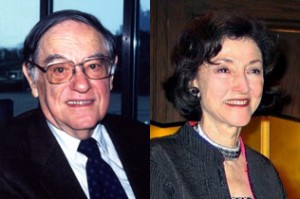
Columbia University Professor Emeritus Donald Keene, left, will talk with Carol Gluck at Japan Society's Farewell Evening with Donald Keene June 13. (Courtesy of Japan Society)
By JQ magazine editor Justin Tedaldi (CIR Kobe-shi, 2001-02) for Examiner.com. Visit his page here for related stories.
This evening (June 13), New York’s Japan Society adds another page to its storied history by hosting the Farewell Evening with Donald Keene, a final talk with Columbia University’s Professor Emeritus and Shincho Professor Emeritus of Japanese Literature.
A scholar, author and translator for over 50 years, Keene is a paragon in the field of Japanese studies. As the translator of legendary works from Mishima, Chikamatsu and Bashō and the writer of dozens of books in his own name (some written in Japanese), Keene’s achievements in bringing the island nation’s culture closer to the West are incalculable.
Upon his decision to retire this spring and become a Japanese citizen, the indefatigable Keene—who turned 89 last week—will speak at Japan Society about his appreciation for Japan, its literature and culture, his recollections of the past, and his hopes for the future as he discusses what motivated him to move permanently to Japan in light of the recent tsunami and earthquake. Moderated by his Columbia University colleague (and fellow celebrated Japanologist) Carol Gluck, the evening will be full of memories.

